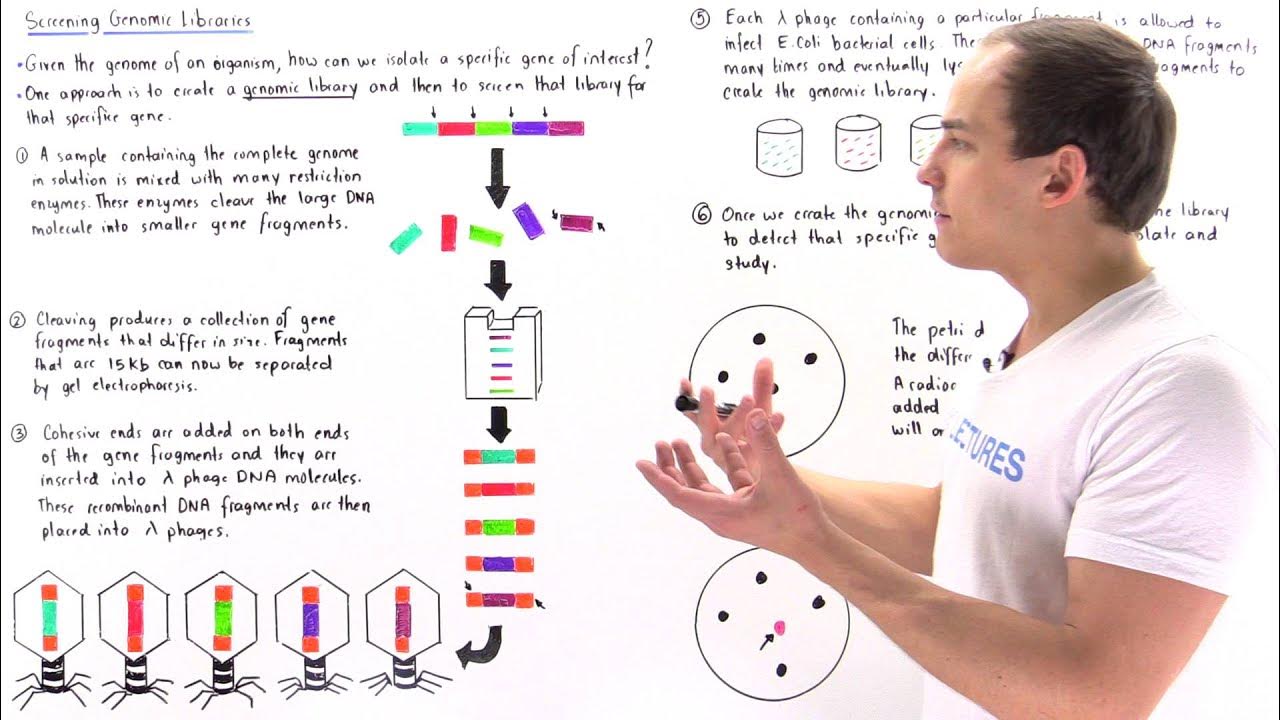Restriction Digestion of DNA
Summary
TLDRThis video tutorial guides viewers through the process of performing a restriction digest on Lambda DNA using the enzymes Eco R1, Hindi 3, and Pst1. It details the setup of a microcentrifuge tube rack with color-coded tubes for each enzyme, the transfer of Lambda DNA and 2x restriction buffer, and the addition of the respective enzymes. The script emphasizes the importance of proper technique and cleanliness. It concludes with incubation instructions and a teaser for a follow-up video on analyzing the digested DNA using agarose gel electrophoresis.
Takeaways
- 🧬 Learn how to perform a restriction digest of Lambda DNA.
- 🔪 Use three specific restriction enzymes: PstI, EcoR1, and HindIII.
- 🧪 Prepare samples of the enzymes and Lambda DNA on ice for the activity.
- 🌈 Organize samples with color-coded microcentrifuge tubes for each enzyme.
- ✍️ Label tubes with initials, date, and enzyme type for clear identification.
- 🔬 Transfer 4 µL of Lambda DNA to each color-coded tube for the digest.
- 💧 Add 2x restriction buffer to each tube, with specific volumes for each enzyme's tube.
- 🚫 Work at ice level to ensure the accuracy of the sample transfer.
- ⚔️ Add 1 µL of each restriction enzyme to the corresponding tube.
- 🔁 Mix the components by gently flicking the tubes after adding enzymes.
- 🌀 Centrifuge the tubes briefly to collect the samples at the bottom.
- 🔝 Incubate the samples at 37°C for 30 minutes or overnight at room temperature.
- 📊 Post-digest, analyze the samples using an agarose gel electrophoresis as shown in a separate video.
Q & A
What is the main purpose of the video?
-The main purpose of the video is to teach viewers how to perform a restriction digest of Lambda DNA using specific restriction enzymes.
Which restriction enzymes are used in the activity described in the video?
-The restriction enzymes used in the activity are PstI, EcoR1, and HindIII.
What are the necessary samples and materials needed for this activity?
-The necessary samples and materials include EcoR1, HindIII, and PstI restriction enzymes, Lambda DNA, 2x restriction buffer, color-coded microcentrifuge tubes, and a micropipette.
Why is it helpful to use color-coded tubes in this activity?
-Using color-coded tubes helps to organize and keep track of the different samples during the restriction digest activity.
How should the Lambda DNA be transferred to the tubes labeled L, E, P, and H?
-Four microliters of Lambda DNA should be transferred from the stock tube to each of the color-coded tubes using a fresh tip for each transfer.
What is the volume of 2x restriction buffer added to each color-coded tube?
-Six microliters of 2x restriction buffer are added to the tube labeled L, and five microliters are added to the tubes labeled E, P, and H.
How much of each restriction enzyme should be added to the corresponding tubes?
-One microliter of each restriction enzyme should be added to the respective tubes.
What is the purpose of spinning the samples in a microcentrifuge?
-Spinning the samples helps to collect the samples at the bottom of each tube, ensuring that all components are mixed properly.
What is the incubation condition for the restriction digest reactions?
-The samples should be incubated for 30 minutes at 37°C or overnight at room temperature.
What should be done after the incubation is complete?
-After the incubation, the samples are ready to be loaded and run for analysis on an agarose gel, as shown in a separate video.
Why is it important to reset the micropipette and use a fresh tip for each transfer?
-Resetting the micropipette and using a fresh tip for each transfer ensures accuracy in volume measurements and prevents cross-contamination between samples.
Outlines

Esta sección está disponible solo para usuarios con suscripción. Por favor, mejora tu plan para acceder a esta parte.
Mejorar ahoraMindmap

Esta sección está disponible solo para usuarios con suscripción. Por favor, mejora tu plan para acceder a esta parte.
Mejorar ahoraKeywords

Esta sección está disponible solo para usuarios con suscripción. Por favor, mejora tu plan para acceder a esta parte.
Mejorar ahoraHighlights

Esta sección está disponible solo para usuarios con suscripción. Por favor, mejora tu plan para acceder a esta parte.
Mejorar ahoraTranscripts

Esta sección está disponible solo para usuarios con suscripción. Por favor, mejora tu plan para acceder a esta parte.
Mejorar ahora5.0 / 5 (0 votes)






